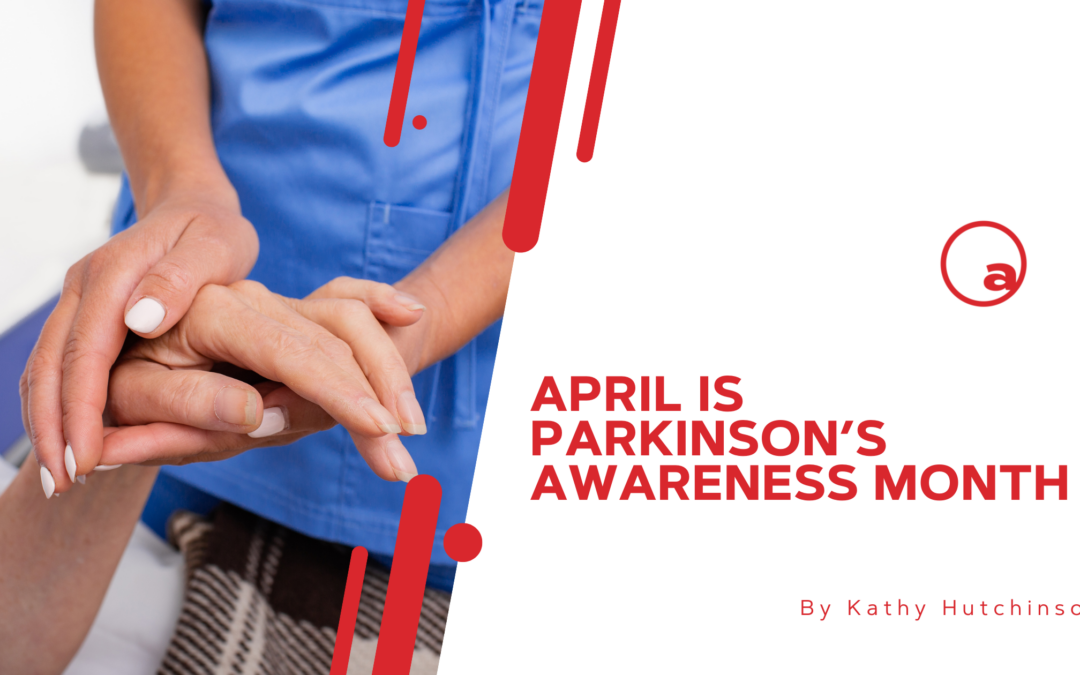What is Parkinson’s disease?
Parkinson’s is a progressive, degenerative disease that unfortunately has no cure. People with Parkinson’s Disease (PD) have a deficiency in one of the nervous system’s chemical messengers called dopamine. In general, chemical messengers (called neurotransmitters) regulate different functions in the body, including heart rate, lung function, sleep, concentration, muscle movement, and much more. Specifically, dopamine acts in the areas of the brain that are responsible for things like memory, learning, mood, and movement.
People with PD have both motor and non-motor symptoms. Common, early, motor symptoms are:
- A resting tremor
- Small handwriting (micrographia)
- Stiffness (including a masked face)
- Slow movement (bradykinesia)
- A soft or low voice
Non-motor symptoms are harder to correlate. Common, early, non-motor symptoms of PD are:
- Fatigue
- Pain
- Sleep disturbances
- Depression
- Cognition difficulties
There is a saying that “if you’ve met one person with Parkinson’s, you’ve met one person with Parkinson’s.” That means all, some, or none of the above may be symptoms. Also, these are early signs of PD but they can all be caused by other things. Someone with pain, or stiffness may have an injury. A change in the voice could be caused by a chest cold. Some medications can cause a lot of these symptoms as well.
The important thing to do is talk to your doctor if you have any of these symptoms that can’t be explained by something else. Not everything that looks like Parkinson’s disease is Parkinson’s disease.
How is Parkinson’s Disease Treated?
The right team of providers is key. A neurologist, speech therapists, physical and occupational therapists, and even fitness professionals are all crucial parts of the team. Medication also plays a part in treating PD. Levodopa is the most effective medication and works to increase the amount of dopamine in the brain and reduce symptoms such as stiffness and tremors. There are even some surgical options available.
Exercise and Parkinson’s Disease
While there are multiple treatments for Parkinson’s, they only help manage symptoms. They do not cure the disease. While research is ongoing to find better treatment and ultimately a cure, scientists have discovered that the biggest factors in slowing down the progression of PD is healthy eating and regular exercise.
Eating a Mediterranean-style diet that includes whole grains, fresh fruits and vegetables, and healthy fats may slow the progression of Parkinson’s. Research also supports following the Mediterranean diet for the prevention of heart disease and cancer, increasing lifespan, and healthy aging.
Along with healthy eating, exercise has also been shown to slow the progression of Parkinson’s disease. Dose, intensity, complexity, repetition, and specificity all matter when designing a workout program for someone with PD. The Surgeon General’s overall recommendations for exercise are 150 minutes of moderate intensity or 75 minutes of vigorous exercise per week. The recommendations for someone with Parkinson’s disease is 150 minutes of moderate to vigorous exercise per week that includes cardio, strength, balance/agility, multitasking, and stretching. Incorporating all of these components makes the workout extremely functional.
Cardio
Aerobic workouts that incorporate circuit training or high intensity interval training (HIIT) are effective in slowing the progression of PD. Always make sure that the intensity level is determined by what is safely possible. If you have injuries or other conditions (like heart disease or other neurological disorders), always define what’s safe within the confines of what else is going on in your body.
Strength
Functional strength training includes strengthening the upper back muscles to help with upright posture. Things like split squats will help with maintaining the strength needed to get off the floor. Core strengthening will help counteract falls by improving balance. Calculating simple math problems while doing chair squats is a great way to incorporate multi-tasking into the workout.
Balance/Agility
Basic balance exercises are great. Arm swing while walking can diminish in people with Parkinson’s disease and has a negative impact on balance. Holding a one-pound hand weight, or even a rolled-up magazine, in each hand while out on a walk can work as a reminder to swing your arms.
Stretching
Focus stretching areas that are typically tight to help counteract the “Parkinson’s Posture.” Stooped or rounded shoulders, decreased low back curve, and forward lean of the head or whole body are very common in people with Parkinson’s. Be sure to include the calves, hip flexors, and chest muscles in your stretching routine.
Rock Steady Boxing
Rock Steady Boxing is an intensive and rigorous boxing-based workout designed for people with Parkinson’s disease and is offered at Active Wellness Center in Napa. Rock Steady Boxing is a non-contact, boxing based workout. It incorporates all of the functional aspects of a workout that are important for people with Parkinson’s in a fun, social environment. Drills with heavy bags, focus mitts, speed bags, shadow boxing, and more are utilized throughout the workout.
Why boxing? Without even realizing it, boxers in the program are getting everything they need in one place. Boxing improves hand eye coordination, balance, core strength, speed of movement, mental focus, and much more. Memory is required to remember the boxing combinations. Repeating patterns helps rewire the brain.
Along with movement challenges, there is an emotional impact that comes with PD. People with PD can feel isolated because they have difficulty communicating or are embarrassed by a tremor and don’t want to leave the house. Rock Steady Boxing includes partner drills, get to know you activities, and competitions to provide the social atmosphere needed to improve mood, mental focus, and decrease stress. And let’s face it – it’s just fun to hit things!
Conclusion
Fighting back against Parkinson’s disease includes having a strong healthcare team, eating right and exercising. It doesn’t matter what you do, just get out there and do it!
Always check with your doctor before starting an exercise program. If you have other medical conditions, like heart disease, be sure to ask if high intensity exercise is appropriate.
Check out the Parkinson’s Foundation website for information and resources.
—
Team Active content is not medical advice; it’s inspiration to LIVE ACTIVELY. Operating five Active Wellness Centers in California and Oregon, we strategically partner with hospital systems like Providence in Petaluma and Napa, California as well as Lake Oswego and Hillsboro, Oregon. Active Wellness Center at NorthBay Health is powered by NorthBay Health in Vacaville, California.
Active’s strategic healthcare partnerships demonstrate our commitment to supporting healthy lifestyles in the communities we serve. Our community health clubs and gyms provide motivating fitness, weight loss, strength-training, medical fitness, aquatics and swim lessons, youth fitness and childcare programs, and group fitness including yoga, Zumba®, barre, Pilates, dance and cycling. *
Check the Active Wellness Center blog often for more healthy lifestyle tips and resources to support your active lifestyle! Click here for a free guest pass to your local Active Wellness Center.
*Active Wellness Center’s program and facility offerings may vary by location.

